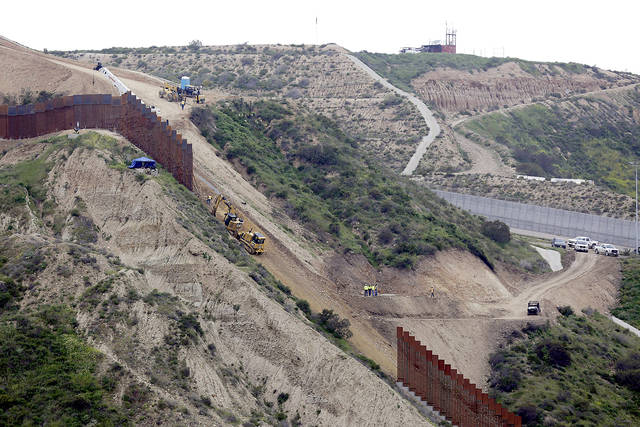Trump proposes record spending, trillion-dollar deficit

WASHINGTON President Donald Trump proposed a record $4.7 trillion budget on Monday, pushing the federal deficit past $1 trillion but counting on optimistic growth, accounting shuffles and steep domestic cuts to bring future spending into balance in 15 years.
WASHINGTON — President Donald Trump proposed a record $4.7 trillion budget on Monday, pushing the federal deficit past $1 trillion but counting on optimistic growth, accounting shuffles and steep domestic cuts to bring future spending into balance in 15 years.
Reviving his border wall fight with Congress, Trump wants more than $8 billion for the barrier with Mexico, and he’s also asking for a big boost in military spending. That’s alongside steep cuts in health care and economic support programs for the poor that Democrats — and even some Republicans — will oppose.
ADVERTISING
Trump called his plan a bold next step for a nation experiencing “an economic miracle.” House Speaker Nancy Pelosi called his cuts “cruel and shortsighted … a roadmap to a sicker, weaker America.”
Presidential budgets tend to be seen as aspirational blueprints, rarely becoming enacted policy, and Trump’s proposal for the new fiscal year, which begins Oct. 1, sets up a showdown with Congress over priorities, especially as he reignites his push for money to build the U.S-Mexico border wall.
The deficit is projected to hit $1.1 trillion in the 2020 fiscal year, the highest in a decade. The administration is counting on robust growth, including from the Republican tax cuts — which Trump wants to make permanent — to push down the red ink. Some economists, though, say the bump from the tax cuts is waning, and they project slower economic expansion in coming years. The national debt is $22 trillion.
Even with his own projections, Trump’s budget would not come into balance for a decade and a half, rather than the traditional hope of balancing in 10.
Titled “A Budget for a Better America: Promises Kept. Taxpayers First,” Trump’s proposal “embodies fiscal responsibility,” said Russ Vought, the acting director of the Office of Management and Budget.
Despite the large projected deficits, Vought said the administration has “prioritized reining in reckless Washington spending” and shows “we can return to fiscal sanity.”
The budget calls the approach “MAGAnomics,” after the president’s “Make America Great Again” campaign slogan.
Some fiscal watchdogs, though, panned the effort as more piling on of debt by Trump with no course correction in sight.
Maya MacGuineas, president of the Committee for a Responsible Federal Budget, said Trump “relies on far too many accounting gimmicks and fantasy assumptions and puts forward far too few actual solutions.” She warned the debt load will lead to slower income growth and stalled opportunities for Americans.
Perhaps most notably among spending proposals, Trump is returning to his border wall fight. Fresh off the longest government shutdown in history, his 2020 plan shows he is eager to confront Congress again over the wall.
The budget proposes increasing defense spending to $750 billion — and building the new Space Force as a military branch — while reducing nondefense accounts by 5 percent, with cuts recommended to economic safety-net programs used by many Americans. The $2.7 trillion in proposed reductions over the decade is higher than any administration in history, they say.
On Capitol Hill, the budget landed without much fanfare from Trump’s GOP allies, while Democrats found plenty not to like.
“Dangerous,” not serious, a “sham,” they said. Senate Democratic Leader Chuck Schumer called it an “Alice in Wonderland document.”
The plan sticks to budget caps that both parties have routinely broken in recent years. To stay within the caps, it shifts a portion of the military spending, some $165 billion, to an overseas contingency fund, which some fiscal hawks will view as an accounting gimmick.
The budget slashes $2 trillion from health care spending, while trying to collect $100 million in new fees from the electronic cigarette industry to help combat a surge in underage vaping. It provides money to fight opioid addiction and $291 million to “defeat the HIV/AIDS epidemic.”
It cuts the Department of Housing and Urban Development by 16 percent and Education by 10 percent, but includes $1 billion for a child care fund championed by the president’s daughter, Ivanka Trump, a White House adviser.
Trump is returning to old battles while refraining from unveiling many new initiatives. He re-opens plans for repealing “Obamacare,” imposing work requirements for those receiving government aid and slashing the Environmental Protection Agency by about a third — all ideas Congress has rejected in the past.
The budget proposes $200 billion toward infrastructure, much lower than the $1 trillion plan Trump once envisioned, but does not lay out a sweeping new plan.
By refusing to raise the budget caps, Trump is signaling a fight ahead. The president has resisted big, bipartisan budget deals that break the caps — threatening to veto one last year — but Congress will need to find agreement on spending levels to avoid another federal shutdown in the fall.
Conservatives railed for years against deficits that rose during the first years of Barack Obama’s administration as tax revenue plummeted and spending increased during the Great Recession.
But even with Republican control of Congress during the first two years of the Trump administration, deficits were on a steady march upward.


